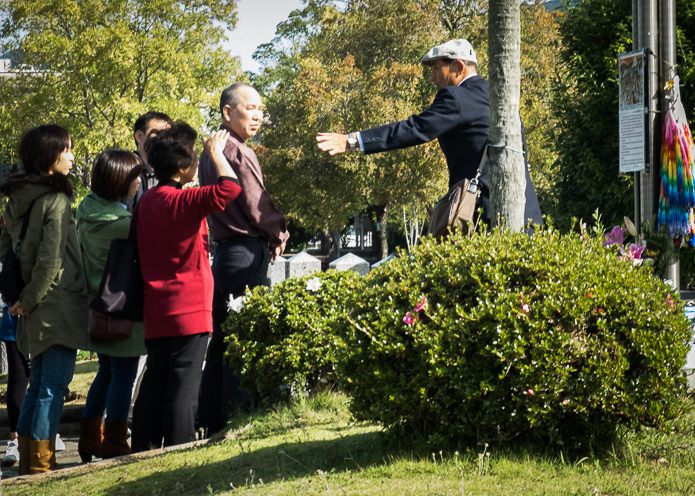
Inosuke Hayasaki (早崎猪之助) (83), atomic bomb survivor, shares his story and message of peace at Nagasaki Peace Park. Photo: © Olivia Fermi 2014.
“Nuclear war ended in Nagasaki! Nagasaki is the period! Peace starts from Nagasaki!” – Takashi Nagai (永井 隆), Peace Tower
A life long desire to experience traditional Japanese culture, aesthetics and spiritual practice motivated my first trip to Japan, along with a more recent urge to follow the Neutron Trail to Hiroshima and Nagasaki. The US dropped atomic bombs on both cities in August 1945, ending World War II. To this day, humanity struggles to make sense of what happened. Victory? Tragedy? These questions are part of a larger movement toward healing that I hope to support with my Neutron Trail journey. When a Japanese friend and photographer Noriko Nasu Tidball (則子 那須) said she wanted to witness my pilgrimage and offered to accompany me, I was delighted.
Although Noriko has lived in Canada for over twenty years, she told me when she goes home to Japan she reverts to a completely traditional Japanese mindset and way of being. As a Westerner brought up in an academically minded family, I was taught to actively comment on and inquire into, as way to show appreciation and to learn. Occasionally on our trip it seemed I was asking too many questions — or was I? Happily we talked about our vastly different assumptions and deepened our friendship as the trip progressed.
What we share without effort is a photographer’s sense of pace and a keen sensitivity to the subtle energies of people and places. Together, over two days, along with another friend and fellow photographer Stephen Imbler from San Francisco, we visited the Nagasaki Peace Park, Atomic Bomb Museum and Nagasaki University’s Atomic Bomb Disease Institute.
We visited Nagasaki before Hiroshima, but after having begun the Japan adventure at Noriko’s family home, touring Wakayama prefecture for a couple of days. A Wakayama highlight was visiting my first Shinto shrine. Noriko taught me how to ritually cleanse myself and the shrine, with water. Although the inner buildings are private to practitioners, the outer complexes of Japanese shrines and Buddhist temples are open, seeming to invite the sacred into the secular with ease. Noriko’s parents were married at this shrine and in the half hour we were there exploring and photographing, I witnessed individuals praying and families celebrating with their children.
And so it was, by the time we arrived in Nagasaki I was already feeling the deep healing power of ongoing prayer culture in Japan. Nagasaki Peace Park has a loving peaceful quality, reminiscent of what I discovered in that first shrine in Wakayama, as in the many shrines and temples I experienced throughout the three–week trip. The Nagasaki Peace Park is a large open space with a courtyard, grassy areas and statues to peace donated from countries around the world. It feels like many people, over a long time have been adding their prayers for peace. Noriko and I remarked to each other on the palpable energy of love and acceptance in the air.
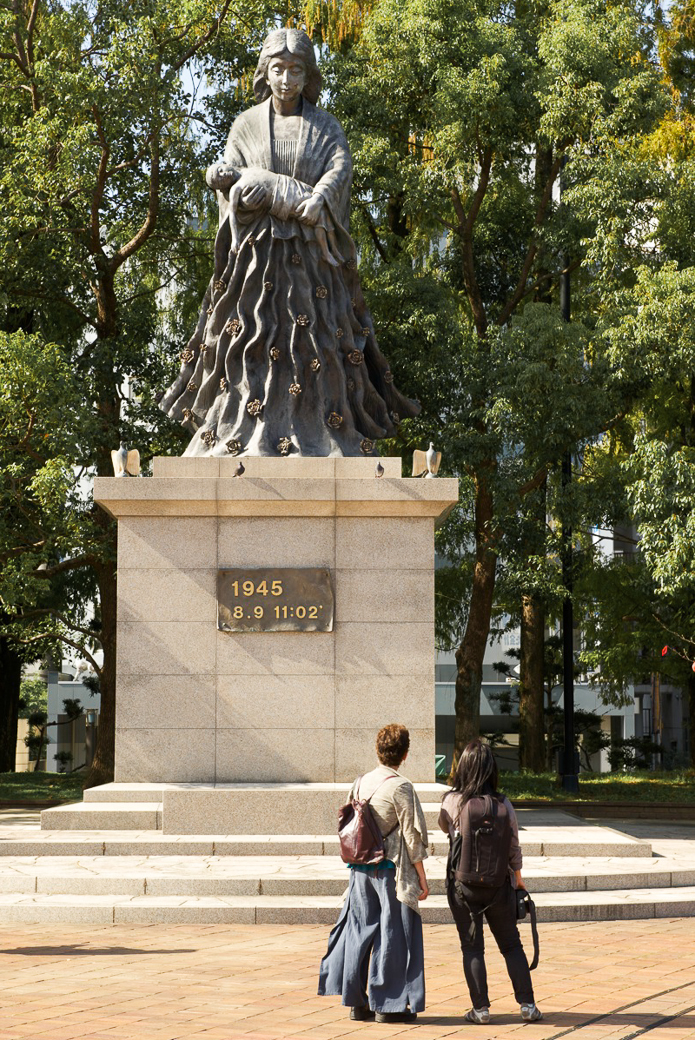
Olivia Fermi and Noriko Nasu Tidball (left to right) viewing Atomic Bombing 50th Anniversary Commemorative Projects Monument by Naoki Tominaga, Nagasaki Peace Park. “Embodied in the monument is the sculptor’s reminder that the child is like Japan on the day of the atomic bombing, while the mother represents the support provided by the countries of the world in Japan’s efforts to build the peaceful nation it has become today.” – from explanatory plaque. Photo: © Stephen Imbler 2014.
As we were walking and taking photos, Noriko noticed an older Japanese man talking to some Japanese people and went over to listen. She told me he was a hibakusha (atomic bomb survivor) and beckoned us to him. Noriko introduced me to Inosuke Hayasaki (早崎猪之助) and we began to talk, with Noriko translating. I was struck with Hayasaki’s intensely alive presence — he is a trained story teller with the Nagasaki Peace Movement Association. Hayasaki was 14 when the bomb fell and only survived because his boss at the weapons factory, where he was working, coincidentally told him to work that morning, by a pillar. Thirty others near young Hayasaki, including his boss, were instantly killed. Everything about the man says he offers his life as an example to us all: of transforming suffering to forgiveness; and loss into generosity.
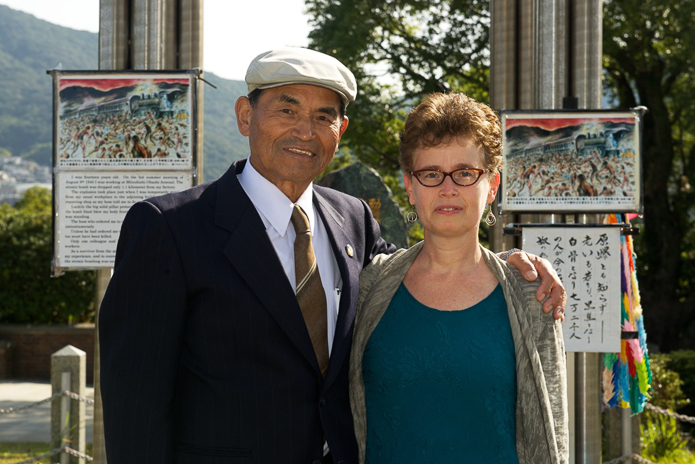
Iinosuke Hayasaki (早崎猪之助) (83), atomic bomb survivor and Olivia Fermi, Nagasaki Peace Park. Photo: © Stephen Imbler 2014.
Intuitively I felt it the moment to let him know that my grandfather Enrico Fermi was deeply involved with the development of the atomic bomb. I expressed it without expecting any particular outcome, simply feeling it was important for him to know. Hearing it, via Noriko’s translation, Hayasaki took my hand and put his other arm around me. I was deeply moved by his open–hearted acceptance of all that happened, implying it is only together that we can create a more loving future for humanity.
We walked on to the marker for the atomic bomb’s epicenter. Noriko’s legs felt weak and I felt a shudder. The marker stands next to a river, reminding us of the hibakusha who burned with radiation and fire, desperately seeking water to quench their fiery thirst. So many of them died there, right where we were standing.
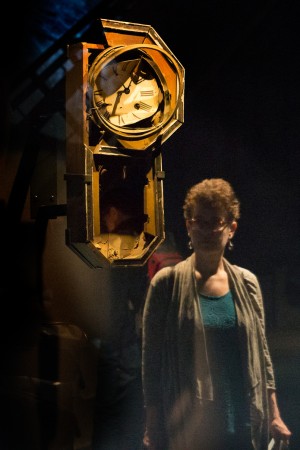
Clock found in Nagasaki stopped at time of atomic bomb detonation: 11:02 am (August 9, 1945) and reflection of Olivia Fermi viewing clock, Nagasaki Atomic Bomb Museum. Photo: © Noriko Nasu Tidball 2014.
Around the corner is the Atomic Bomb Museum and as I was warned, it was intense and deeply saddening to see the images and artifacts from the atomic bombing. We each walked on our own through the exhibits and only at the end sat down to compare experiences. We both felt it viscerally — Noriko had stomach cramps and I felt the grief of mourning so many lost souls.
Stephen believes the use of atomic weapons on Japan was wrong and he also thinks the primary motivation of the US was to end a terrible war. On the Neutron Trail, I appreciate such nuanced thinking. It bothered Stephen that an obvious motivation of the US and other key details of historical context were missing from the museum’s didactic displays. He noticed Japan’s invasion of China and its attack on Pearl Harbor were not listed — only the Soviet attack on Japan. Noriko confirmed some aspects of the history haven’t usually been taught in Japanese schools. Perhaps it explains the occasional hostile stare I encountered, but only in the Nagasaki Museum. By far, throughout the trip I felt welcome and comfortable as a visible foreigner.
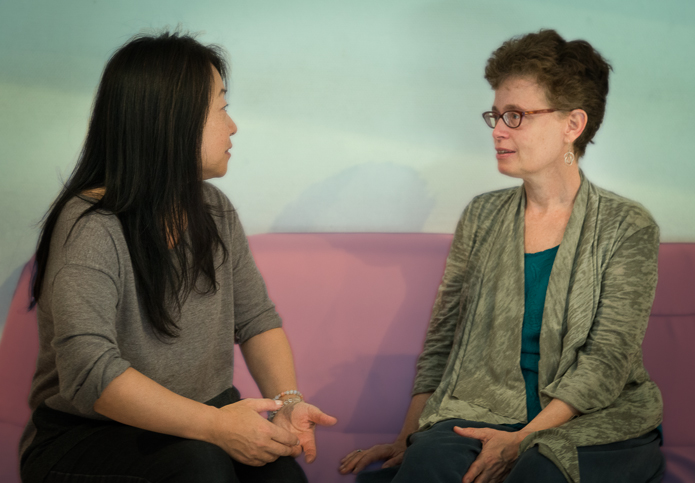
Norikio Nasu Tidball and Olivia Fermi (left to right) sharing our impressions in the Nagasaki Atomic Bomb Museum. Photo: © Stephen Imbler 2014.
As we continued to debrief, Noriko opened up to me in a way I hadn’t expected. When she was in 2nd or 3rd grade, she told me, at school they were gathered in the gymnasium and made to look at graphic images of wounded and dying hibakusha and devastation from the bombings. Noriko said the images were even more graphic than the displays we had just viewed. She had nightmares and for a while was afraid to go anywhere without holding her mom’s hand. It seemed our visit was stirring up those old feelings.
Her mom lived and worked in Kobe in the same kind of military factory as Hayasaki, the hibakusha we had just met. We sensed our bond to each other, each on a pilgrimage; and that we were bridging from opposite ends, Noriko from the east and me from the west, yet connecting on a universal level. I learned something more about my friend. Noriko says seeing those disturbing black and white images as a young one influences her photography, even now, in some way. For her, photography is an expressive art form and a way to communicate the wide range of human emotions she witnesses in her life and travels.
Before leaving Vancouver, thanks to the personal recommendation of Joy Kogawa, author, I read The Bells of Nagasaki by Takashi Nagai (永井 隆). Nagai was a poet and a physician at Nagasaki University. He and his fellow workers were near the Nagasaki epicenter and all severely wounded or killed by the atomic bomb, detonated there on August 9, 1945. Nagai and a few of his mates managed to provide medical care to many, while they themselves were suffering from the after effects. I had been moved and inspired by Nagai’s personal account of what happened and so we walked from the Museum to see his final home. It’s a tiny hut, now part of a small museum in Nagai’s honor, including many of his poetic and inspiring words to us.
The next day Noriko arranged for us to make an official visit to the Research Center for Nuclear Weapons Abolition and the Atomic Bomb Disease Institute (ABDI) at Nagasaki University. Professor Mariko Mine and Noriko’s friend Assistant Professor Makoto Ihara were our hosts. Since 1962, ABDI’s mission has been to research and educate; to share knowledge with all humanity for the good of all nations.
I was impressed with the breadth of ABDI activities, which had started with ongoing monitoring and sharing of hibakusha’s health and disease statistics; and have grown to include risk management communication about nuclear in general. According to their website, the Institute has an outpost in Kawauchi, a small village in Fukushima Prefecture. Because of radiation levels, Kawauchi’s residents were forced to temporarily evacuate after the accident at Fukushima Dai–ichi in March 2011. A year later, with the help of ABDI, theirs was the first village to welcome its people home. ABDI stationed a public health nurse in Kawauchi and independently confirmed the government’s statement of safety. ABDI communicates openly about risk and safety with the returning villagers, while they continue ongoing monitoring there.
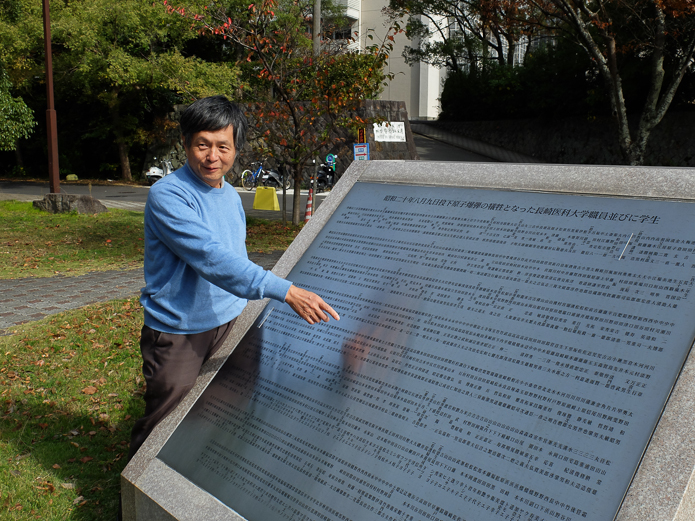
Makoto Ihara showing us memorial listing of all who died from the atomic bomb at Nagasaki University. Photo: © Olivia Fermi 2014.
After our official tour, Ihara showed us a humble monument listing all of the names of the bomb dead of Nagasaki University and a peace prayer shrine I’ll never forget. We climbed a small hill to reach it. Those left alive at the time of the atomic bombing gathered the unidentifiable bones from the Nagasaki University campus and buried them on the top of the hill. Later, the shrine was added, but it didn’t look like anyone had visited in a long time. As is proper in her culture, Noriko suggested we clean the shrine. I cleared branches while she and Ihara washed it with water. Then we added our prayers for the dead and for the living.
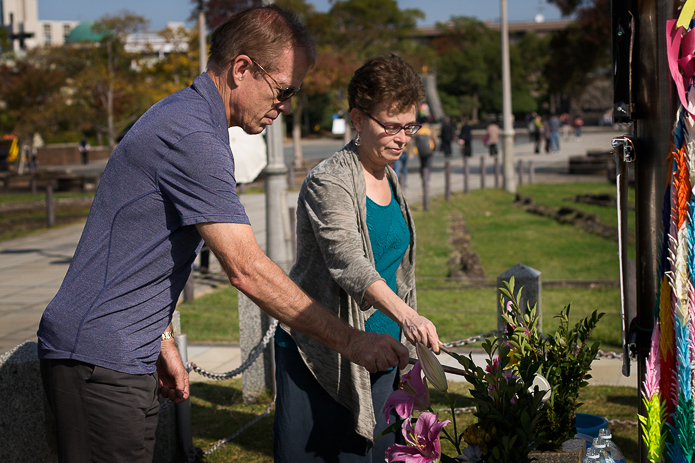
Ritual cleansing with water, Stephen Imbler and Olivia Fermi, Nagasaki Peace Park. Photo: © Noriko Nasu Tidball 2014.
I admire the Japanese pragmatism in their systems. From trains that are always on time and on spot, to design delightfully appearing in unexpected places, the Japanese have found ways to marry practicalities of daily life with a care, I believe, stems from their prayer culture. On that little hill, and throughout the journey, I felt happy and grateful for the opportunity to participate in the Japanese way.


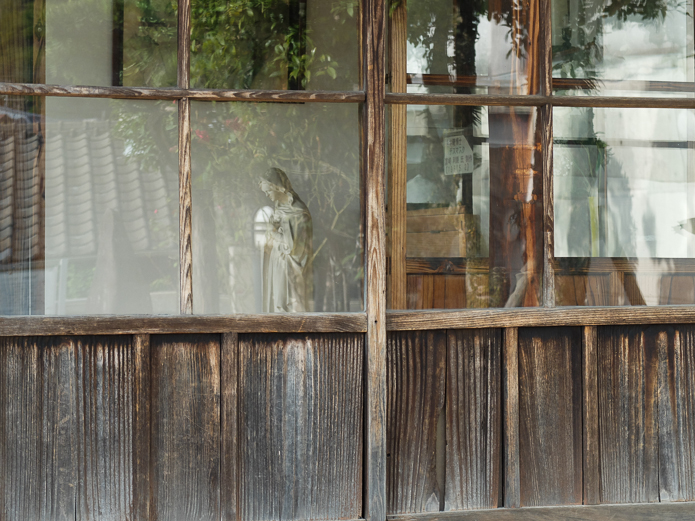
 Twitter
Twitter
Pingback: Hiroshima Atomic Bomb Survivor Heals Herself by Speaking Out 被爆体験を伝えることの大切さ、そしてヒーリング | On the Neutron Trail
Pingback: Japan Healing and Systemic Constellation Therapy | On the Neutron Trail